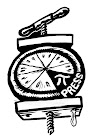Martin Scorsese's "Hugo" is a film rich in surprises. Buried beneath dazzling 3D effects, beautiful 1930-ish Paris locales, and charming children lies a heartfelt work about a topic near and dear to all classic film lovers - our never-ending enchantment with movies and the very serious importance of film preservation.
Based upon the book "The Invention of Hugo Cabret," by Brian Selznick, "Hugo" tells a fanciful story of an orphan boy who lives in the walls of a Paris train station. After his father dies in a fire, Hugo is taken by his brutish uncle to live with him at the station where he maintains the clocks. After the uncle disappears, Hugo continues to maintain the clocks in the station. His days consist of working the clocks, stealing food to survive, dodging the Station Master (who lives to send children to the orphanage) and fixing a machine called an "automoton" - a broken mechanical man whose message Hugo hopes will bring him closer to his dead father. Through some botched attempts at thievery, he comes in contact with a crusty old Toy Seller at the station who makes life miserable for the adorable blue-eyed Hugo by taking possession of the precious notebook that belonged to the boy's father. Luckily for Hugo, he strikes up a totally charming adolescent relationship with the Toy Seller's goddaughter, Isabelle. Isabelle offers to help Hugo retrieve his father's notebook from the Toy Seller and Hugo introduces Isabelle to the movies, something her godfather has forbidden. Through a very clever turn of events , we learn that this old curmudgeon is the great, and very forgotten, early French film maker, Georges Méliès. With the help of a kindly book seller, the children come in contact with a film historian who is fascinated with Méliès, and thus begins a rediscovery of those early masterful films and an appreciation of the master's art.
The early wizard of special effects, Méliès created hundreds of fanciful films that were an expression of his earlier work as a magician. Through trial and error, he discovered that cinema magic (though such techniques as time-lapse photography and multiple exposures) was much more potent than stage magic. Truly flights of fancy, the most enduring of all of his films is the 1910 "Trip to the Moon," with this iconic image:
.
What film lover does not know this image? And yet, in the 1920s and 1930s, when film preservation was not on the radar, only those who actually saw it so long ago remembered. World War I and the rise of Hollywood put an end to Méliès' magical studio. But magic it was.
Films were hand-tinted to an even more magical effect.
If you love movies, your heart will swell because, thanks to the intrepid children, Méliès is restored to his rightful place in cinematic history. The film also gives us a mini-history of early silents up until the glory days of Fairbanks and Chaplin. One of the most charming scenes in the film is one where Hugo and Isabelle, enraptured, watch Harold Lloyd hanging from that clock in "Safety Last."
Ironically, Hugo ends up in a similar situation.
There are so many fun film references for the movie-lover here, including a Hitchcock-like cameo by the director.
The actors are all wonderful. Asa Butterfiled as Hugo makes an adorable orphan and Chloe Grace Moretz, as Isabelle, is just magnificent - an intrepid Nancy Drew with an Ingrid Bergman look. Sacha Baron Cohen, as the Station Master, is not only amusing, but also touching, and Sir Ben Kingsley gives depth and pathos to an almost broken man who, like his automoton, needs to be fixed.
 |
| Sir Ben Kingsley as Georges Melies |
 |
| The real Georges Melies |
Scorsese, who deserves his own revered place in film history, has painstakingly recreated Méliès' films and film making process. Dreams, Magic and Adventure are words that are often used in this film. They are words that accurately describe those early days of film, but still hold true today. Just as the earliest audiences ducked in their seats when they saw the image of an oncoming train on the screen, so, too, do modern audiences when the magical effects of 3-D are well done. Leave it to Scorsese to make the use of 3-D not only magical, but evocative.
Thank you, Martin Scorsese. Wrapped in a beautiful family film is the message all lovers of cinema long to hear: the past is the present and future and all that came before is precious and important.


















0 Yorumlar